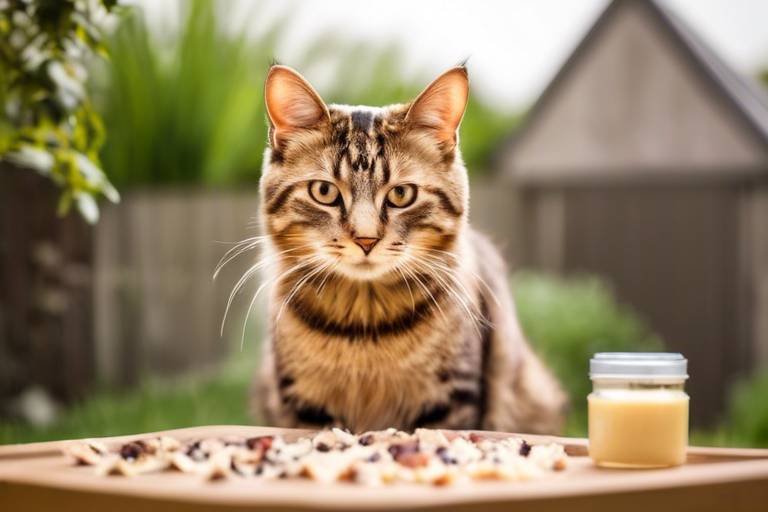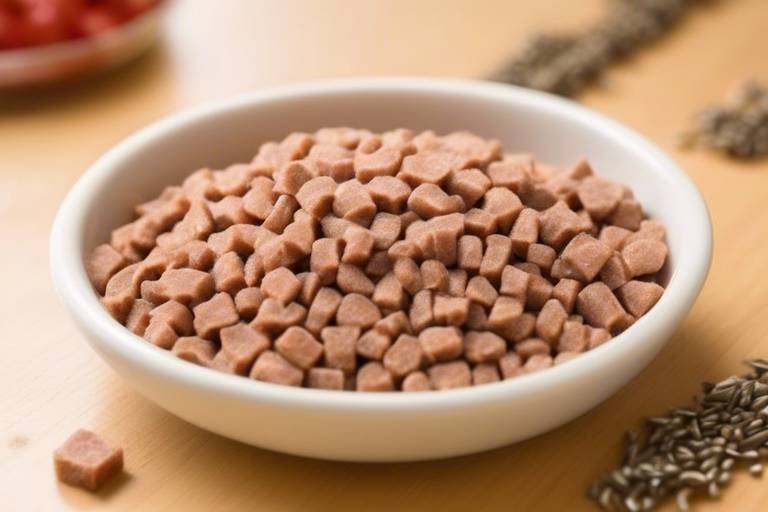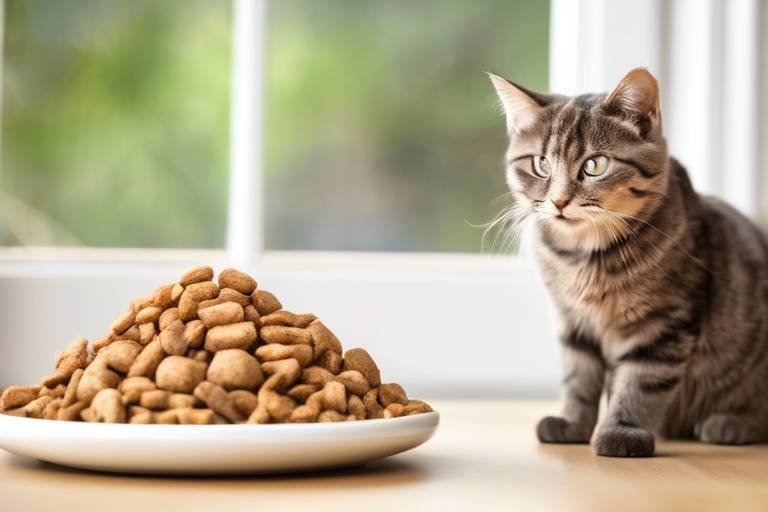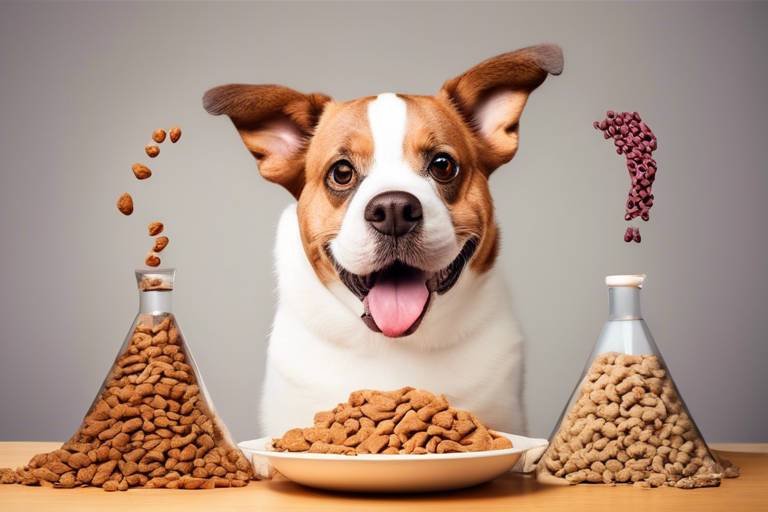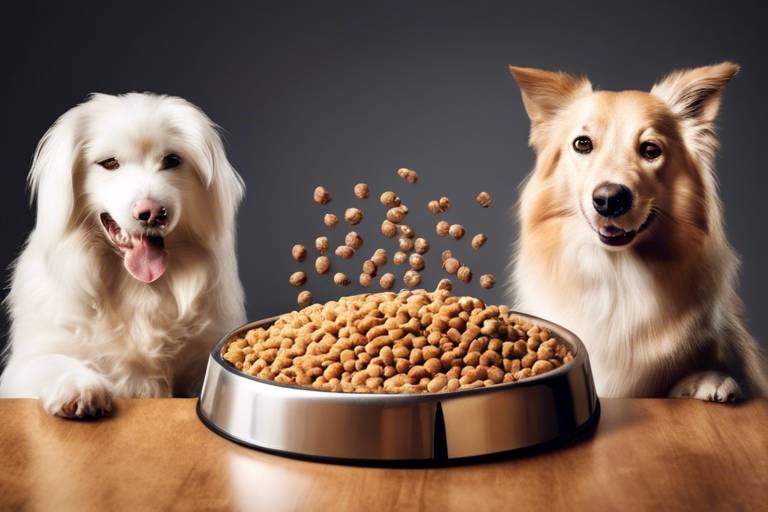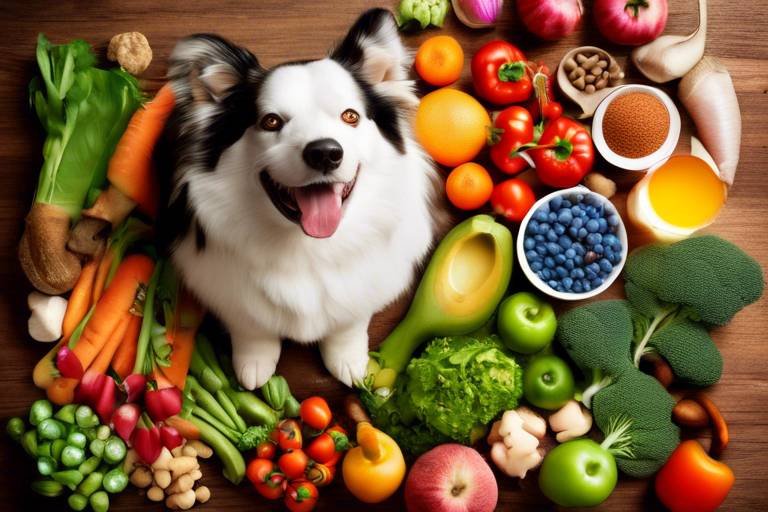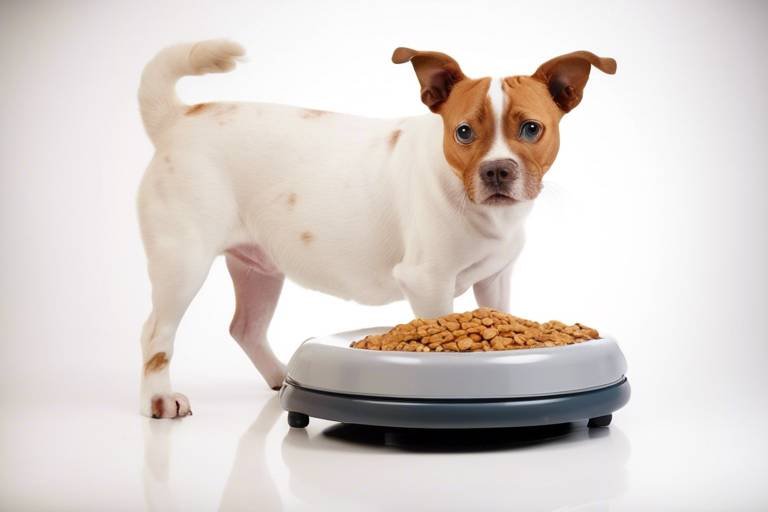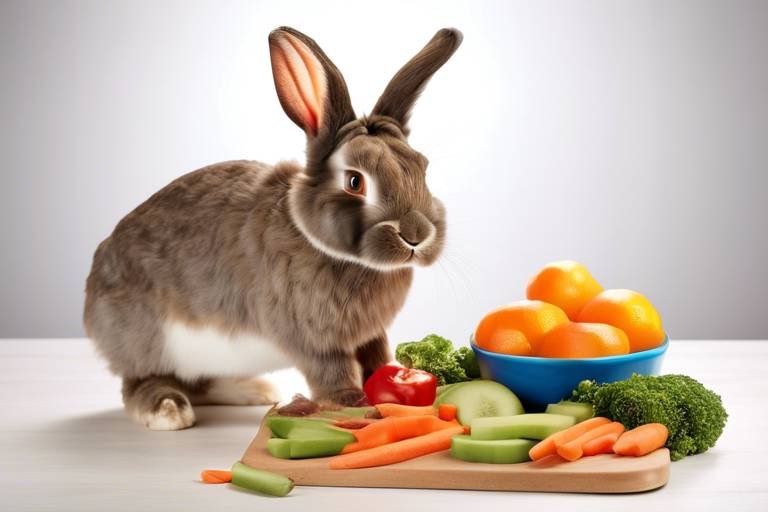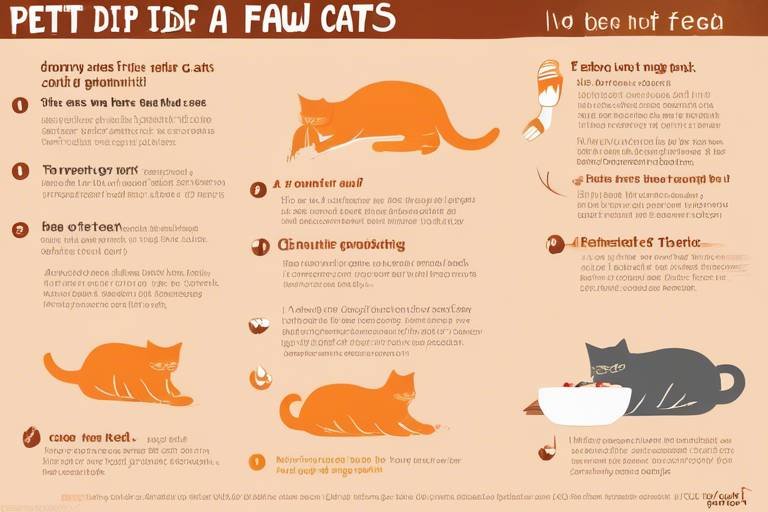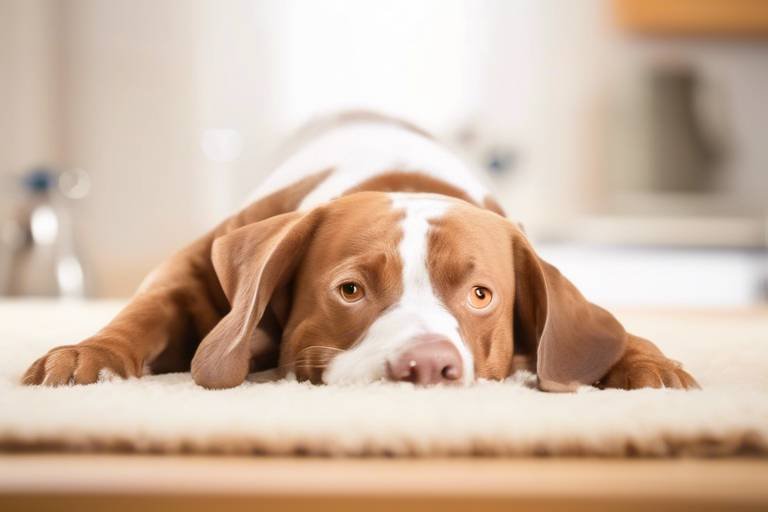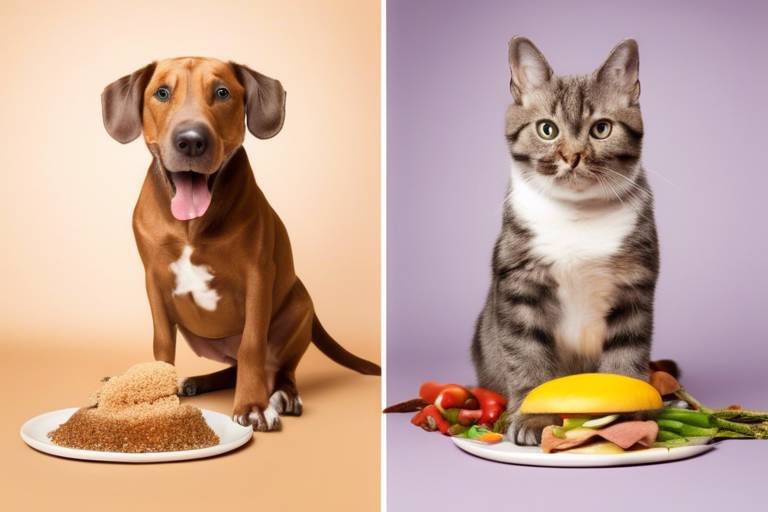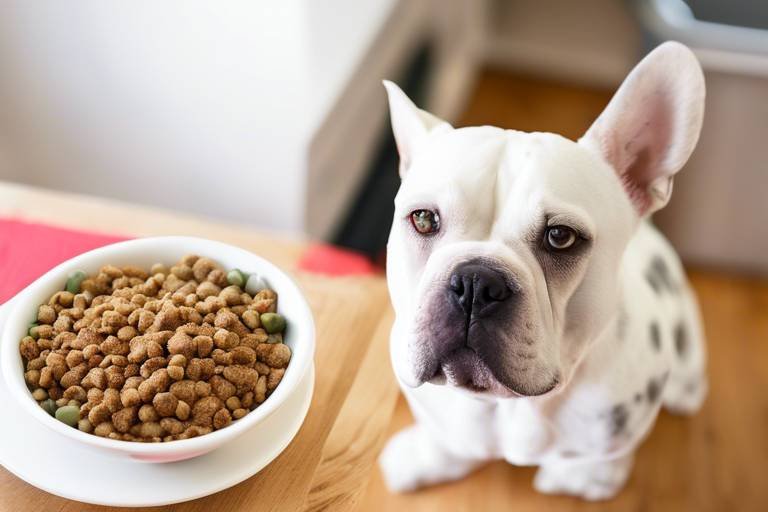How to Make Nutrition a Fun Experience for Pets
Feeding your pet shouldn't be a mundane chore; it can be a delightful, engaging experience that both you and your furry friend look forward to! Imagine turning meal times into a mini-celebration, where every bite is not just about nutrition but also about joy and excitement. In this article, we're diving into creative ways to enhance your pet's nutrition while making mealtime enjoyable. From interactive feeding toys to homemade recipes, we’ll explore tips and activities that transform the act of eating into a fun and bonding experience.
Before we jump into the fun stuff, let's lay down some foundational knowledge about pet nutrition. Just like humans, pets need a balanced diet to thrive. This includes essential nutrients such as proteins, fats, carbohydrates, vitamins, and minerals. Each type of pet—be it a dog, cat, or even a rabbit—has its own specific dietary requirements. Understanding these basics is crucial for making informed decisions about what to feed your pet. After all, you wouldn’t want to serve your cat a dish meant for a dog, right? So, let’s break down the essentials:
| Pet Type | Essential Nutrients | Common Dietary Needs |
|---|---|---|
| Dogs | Proteins, Fats, Carbohydrates | High protein for muscle health, fiber for digestion |
| Cats | Proteins, Fats, Vitamins | High protein, taurine for heart health |
| Rabbits | Fiber, Vitamins | High fiber for digestive health, greens for vitamins |
By understanding your pet’s nutritional needs, you can make better choices that lead to a healthier, happier life for your companion.
Now that we have a grasp on nutrition, let’s explore how to make mealtime a playful adventure! Pets thrive on stimulation, and combining play with their feeding can make a world of difference. Imagine your dog working through a puzzle toy to earn their kibble or your cat batting around a treat-filled ball. Not only does this keep them entertained, but it also encourages healthy eating habits. Here are some innovative strategies to consider:
Interactive feeding toys are fantastic tools for keeping your pet engaged during mealtime. These toys challenge pets to work for their food, promoting both physical activity and mental stimulation. For example, toys that dispense food as your pet plays with them can turn an ordinary meal into a fun game. You might be surprised at how much your pet enjoys the challenge!
If you’re feeling crafty, why not create your own feeding toys? You can use household items like plastic bottles or cardboard boxes to design unique feeding puzzles. Just make sure they’re safe and suitable for your pet’s size and chewing habits. This cost-effective solution not only saves money but allows you to customize the toys to fit your pet’s preferences.
If DIY isn't your thing, don't worry! There are plenty of commercially available interactive feeders designed to engage pets during mealtime. They come in various shapes and complexities, catering to different pet sizes and types. Whether it’s a slow feeder bowl that makes pets work for their food or a treat-dispensing toy, the options are endless!
What’s better than a fun feeding experience? A delicious one! Homemade recipes can be both nutritious and exciting for your pets. Think about adding variety to their meals with simple, healthy ingredients. For instance, you can whip up a batch of pumpkin dog treats or chicken-flavored cat bites. Not only will your pets love the taste, but you’ll also have the satisfaction of knowing exactly what’s going into their food.
Engaging your pet's senses is a fantastic way to enhance their eating experience. Just like us, pets enjoy meals that are visually appealing and aromatic. By introducing different textures, colors, and smells, you can make mealtime an adventure for their senses. For example, adding colorful vegetables to their food can make it more enticing. The crunch of a carrot or the chewiness of a sweet potato can make all the difference in their enjoyment.
Offering a variety of flavors in your pet's diet is crucial. It not only keeps mealtime exciting but ensures a balanced intake of nutrients. Think of it like this: would you enjoy eating the same meal every day? Mixing things up can help prevent boredom and encourage your pet to eat more willingly.
Different textures can also make meals more appealing. Incorporating crunchy, chewy, and soft foods can enhance their enjoyment and satisfaction during feeding. For instance, you might combine dry kibble with wet food or fresh veggies to create a delightful mix that keeps your pet interested.
Establishing a consistent mealtime routine can create a sense of security for pets. Just like children, pets thrive on routine. It helps them know what to expect and when. This section discusses the benefits of routine and how to implement it effectively.
Creating a balanced feeding schedule that aligns with your pet's needs is essential. Consistency in timing can help regulate digestion and improve overall health. For example, feeding your dog at the same time each day can help them feel more secure and less anxious.
Treats can be a great way to reward your pet, but moderation is key. Discover how to incorporate treats into your pet's diet without compromising their nutrition. Healthy options, like carrot sticks or apple slices, can be fun rewards that also contribute to their overall diet.
Don't forget to celebrate your pet's milestones with special meals or treats! This can enhance your bond and create joyful memories associated with nutrition. Whether it’s a birthday or a holiday, making your pet feel special can be as simple as preparing a unique meal or giving them a special treat.
Planning a fun birthday meal for your pet can be a delightful experience. Think about recipes that are safe for your pet and that they’ll absolutely love. You might bake a dog-friendly cake or whip up some special treats that will make their day memorable.
During holidays, consider festive recipes that can make your pet feel included in family celebrations. Just remember to maintain their nutritional needs while treating them to something special. A little creativity can go a long way in making your pet feel loved!
Understanding how nutrition affects your pet's health is essential. Regular vet check-ups and monitoring dietary changes can ensure your pet thrives. Pay attention to any signs of nutritional deficiencies, as early detection can prevent health issues.
Learn to recognize signs that may indicate your pet is not receiving adequate nutrition. Look out for changes in behavior, coat quality, or energy levels. These can all be indicators that it’s time to reassess their diet.
Lastly, don’t hesitate to consult with a veterinarian regarding your pet's diet. Professional guidance can help tailor nutrition plans specific to your pet's needs, ensuring they receive the best care possible.
- What are the signs my pet is not eating enough? Look for weight loss, lethargy, or changes in behavior.
- How can I make my pet's meals more exciting? Introduce variety in flavors and textures, and consider interactive feeding toys.
- Is it okay to give my pet human food? Some human foods are safe, but always check with your vet first.
- How often should I consult my veterinarian about my pet's diet? Regular check-ups are recommended, especially if you notice any changes in behavior or health.
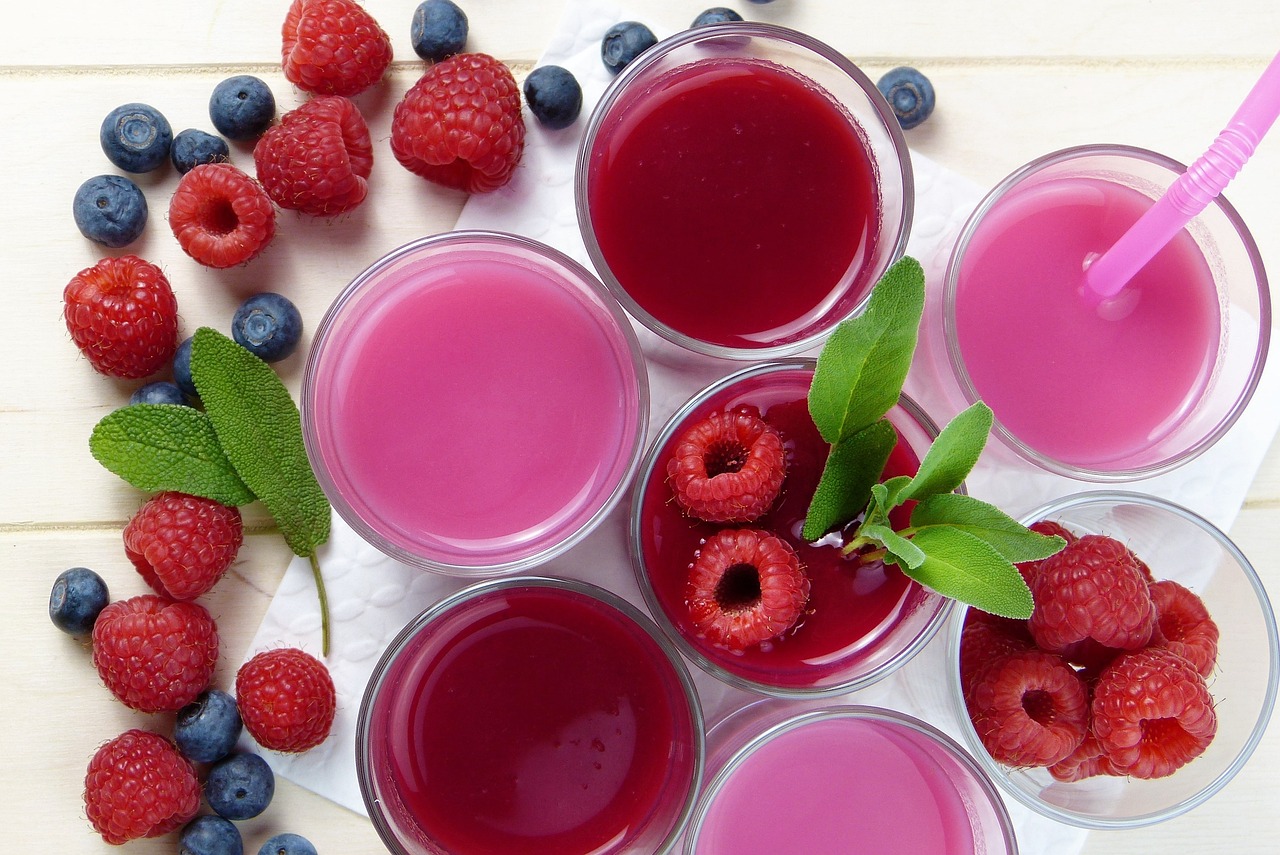
Understanding Pet Nutrition
When it comes to our furry friends, understanding pet nutrition is crucial for ensuring they live a healthy and happy life. Just like humans, pets require a balanced diet that meets their specific nutritional needs. This means providing them with the right mix of proteins, fats, carbohydrates, vitamins, and minerals. But how do you figure out what your pet needs? Well, it starts with knowing the basics!
First off, let’s talk about the essential nutrients that every pet needs. Each nutrient plays a unique role in maintaining your pet's health:
| Nutrient | Function |
|---|---|
| Proteins | Builds and repairs tissues, supports immune function, and provides energy. |
| Fats | Provides energy, supports cell structure, and aids in the absorption of certain vitamins. |
| Carbohydrates | Serves as a primary energy source and aids in digestive health. |
| Vitamins | Supports various bodily functions, including vision, immune response, and blood clotting. |
| Minerals | Essential for bone health, nerve function, and muscle contraction. |
Now, while the above nutrients are essential, it's important to remember that the dietary requirements can vary significantly depending on your pet's species, breed, age, and health status. For example, a growing puppy will have different nutritional needs compared to a senior dog. Similarly, cats require higher protein levels than dogs due to their unique metabolic needs.
Additionally, it’s vital to consider the quality of the food you’re providing. Not all pet foods are created equal! Look for products that list high-quality ingredients and avoid those with fillers or artificial preservatives. Reading labels can feel like deciphering a secret code, but it’s worth it to ensure your pet’s health.
Lastly, don’t forget that hydration is just as important as nutrition. Always make sure your pet has access to fresh, clean water. Proper hydration supports digestion and helps maintain healthy organ function.
In summary, understanding pet nutrition is about more than just filling a bowl with food. It involves knowing what your pet needs, considering their unique requirements, and choosing high-quality ingredients. This foundational knowledge will empower you to make informed decisions that promote your pet’s overall health and well-being.
- What are the signs of a well-balanced diet for my pet? Look for healthy skin and coat, consistent energy levels, and normal weight maintenance.
- Should I consult my veterinarian about my pet's diet? Absolutely! Your vet can provide tailored advice based on your pet’s specific needs.
- How can I tell if my pet is allergic to certain foods? Watch for symptoms like itching, digestive issues, or ear infections, and consult your vet for guidance.

Incorporating Play into Mealtime
When it comes to our furry friends, mealtime doesn’t have to be a mundane affair. In fact, it can be an adventure! By , you can transform the act of eating into an engaging experience that stimulates both the mind and body of your pet. Imagine your dog wagging its tail in excitement or your cat pouncing joyfully at the sight of their food! This not only makes mealtime fun but also encourages healthy eating habits. So, how can you achieve this delightful transformation?
One of the most effective ways to combine play and nutrition is through interactive feeding toys. These clever gadgets are designed to challenge your pet to work for their food, turning mealtime into a playful exercise. For instance, treat-dispensing balls or puzzle feeders require pets to solve a challenge to get their food, which keeps them mentally stimulated and physically active. Not only does this prevent boredom, but it also helps in maintaining a healthy weight by slowing down their eating pace.
Interactive feeding toys come in various shapes and sizes, catering to different pets and their unique needs. Here are a few popular options:
- Puzzle Feeders: These require pets to figure out how to access their food, promoting problem-solving skills.
- Treat Balls: Pets must roll the ball around to dispense treats, encouraging movement and play.
- Snuffle Mats: These mats hide food within fabric folds, engaging your pet’s natural foraging instincts.
But wait, you don’t have to spend a fortune on these toys! You can easily create DIY feeding toys using household items. For example, an empty plastic bottle with holes can serve as a treat dispenser, or you can stuff a sock with tennis balls to create a fun tug-of-war toy. The beauty of DIY toys is that they can be customized to suit your pet's preferences and dietary needs, making mealtime a personalized experience.
Creating your own feeding toys can be a fun project. Here’s a simple guide:
1. Find an empty plastic bottle. 2. Clean it thoroughly and remove any labels. 3. Cut small holes in the sides, just big enough for treats to fall out. 4. Fill it with your pet’s favorite snacks. 5. Let your pet roll and play with it to get their reward!
On the other hand, if DIY isn’t your style, there are plenty of store-bought options available that can keep your pet entertained during mealtime. These products range from simple to complex, catering to different pet sizes and types. Investing in a good interactive feeder can be a game-changer, especially for pets that tend to gobble their food too quickly. By making them work for their meals, you’ll not only promote healthier eating habits but also provide them with a fun challenge that keeps them engaged.
In conclusion, incorporating play into mealtime is a fantastic way to enhance your pet's dining experience. By blending fun with nutrition, you’re not only ensuring that your pet enjoys their food but also promoting their overall health and well-being. So why not give it a try? Your pet will thank you with wagging tails and happy purrs!
Q: How can I tell if my pet is enjoying their interactive feeding toys?
A: Look for signs of engagement, such as your pet actively playing with the toy, wagging their tail, or showing excitement when it's mealtime. If they seem bored or uninterested, it might be time to switch it up!
Q: Can I use regular food in interactive toys?
A: Absolutely! Most interactive feeders and toys can accommodate regular dry kibble, but make sure to check the manufacturer's recommendations to avoid any issues.
Q: How often should I rotate toys to keep my pet interested?
A: It's a good idea to rotate toys every week or so. This keeps things fresh and exciting for your pet, ensuring they remain engaged and stimulated.
Interactive Feeding Toys
When it comes to making mealtime a fun and engaging experience for your furry friends, are a game-changer. These toys not only turn feeding into a playful activity but also provide mental stimulation, which is essential for your pet's overall well-being. Imagine your pet eagerly working to unlock their dinner, just like a treasure hunt! With a variety of designs available, these toys can cater to pets of all sizes and breeds, ensuring that every meal is an adventure.
One of the most exciting aspects of interactive feeding toys is their ability to challenge your pet's problem-solving skills. For instance, some toys require pets to roll, nudge, or paw at them to release the food inside. This not only keeps them entertained but also encourages them to eat slowly, which can aid digestion and prevent overeating. It's like turning your pet’s dinner into a fun puzzle!
Here are a few popular types of interactive feeding toys you might consider:
- Food Dispensing Balls: These toys release kibble as your pet rolls them around, making mealtime a game.
- Puzzle Feeders: These require pets to figure out how to access their food, often involving sliding pieces or lifting lids.
- Snuffle Mats: These mats hide food within fabric strips, encouraging your pet to sniff and forage for their meal.
Not only do these toys provide entertainment, but they also promote physical activity, which is crucial for maintaining a healthy weight. Pets that are mentally and physically stimulated are generally happier and less prone to behavioral issues. So, by incorporating interactive feeding toys into your pet's routine, you're not just feeding them; you're enriching their lives!
In addition to store-bought options, many pet owners enjoy creating their own interactive feeding toys using simple household items. For example, you can take a muffin tin, place treats in some of the cups, and cover them with tennis balls. Your pet will have to figure out how to remove the balls to get to the treats, adding an element of challenge and fun to their meal. This DIY approach not only saves money but also allows you to customize the toy to suit your pet's preferences.
In conclusion, interactive feeding toys are a fantastic way to transform mealtime into an engaging and stimulating experience for your pet. They challenge your pet’s mind, promote exercise, and can even help with portion control. So, why not give your furry friend a little extra fun during mealtime? Your pet will thank you with wagging tails and joyful barks!
Q: Are interactive feeding toys suitable for all pets?
A: Most interactive feeding toys are designed for a variety of pets, including dogs and cats. However, it's essential to choose toys that are appropriate for your pet's size and chewing habits.
Q: Can I use interactive feeding toys for all types of food?
A: Yes, many interactive feeding toys can accommodate dry kibble, treats, and even some wet foods. Just ensure that the toy is designed for the type of food you intend to use.
Q: How often should I use interactive feeding toys?
A: You can use these toys during every meal or as a special treat to keep things exciting. It’s a great way to add variety to your pet's feeding routine!
DIY Feeding Toys
Creating your own can be a fun and rewarding experience for both you and your pet. Not only do these toys provide mental stimulation, but they also encourage your furry friend to engage in healthy eating habits. Imagine your pet’s excitement as they work to access their meals, turning mealtime into a delightful challenge! The best part? You can use common household items to whip up these engaging toys.
One popular option is to repurpose a plastic bottle. Simply take an empty plastic bottle, remove the label, and cut a few holes in it. Fill it with your pet's favorite kibble or treats, and watch as they roll it around to get the food out! This not only keeps them entertained but also encourages them to be active. Just make sure the holes are large enough for the food to fall out but not so large that they can swallow the entire bottle.
Another easy and effective DIY toy is the sock and ball method. Take an old sock and place a tennis ball inside it, then tie a knot at the end. This creates a soft, bouncy toy that your pet can toss around. You can even add some treats inside the sock before tying it off for an extra surprise! This method is excellent for dogs that love to fetch.
If you're feeling a bit more crafty, you can create a puzzle feeder using a muffin tin. Simply place small treats or kibble in the cups of the muffin tin and cover them with tennis balls or crumpled paper. Your pet will have to figure out how to remove the balls to access the food, making it a fun and engaging challenge. This can also be a great way to slow down pets that tend to eat too quickly.
Here’s a quick summary of some DIY feeding toy ideas:
| Toy Idea | Materials Needed | Instructions |
|---|---|---|
| Plastic Bottle Feeder | Empty plastic bottle | Cut holes, fill with kibble, and let your pet roll it around. |
| Sock and Ball Toy | Old sock, tennis ball | Place ball in sock, tie a knot, and let your pet play. |
| Muffin Tin Puzzle | Muffin tin, tennis balls, treats | Place treats in muffin cups, cover with balls, and watch your pet solve the puzzle. |
DIY feeding toys are not only an excellent way to keep your pet entertained, but they also provide an opportunity to bond with your furry friend. You can customize these toys based on your pet’s preferences and dietary needs, ensuring that mealtime is both nutritious and fun. So, grab those household items and get creative—your pet will thank you!
- What types of materials are safe for DIY feeding toys? Always use non-toxic materials and avoid anything that could break easily. Items like plastic bottles, old socks, and muffin tins are generally safe.
- Can I use store-bought treats in these DIY toys? Absolutely! Store-bought treats can be used in any of these toys, just ensure they are suitable for your pet's dietary needs.
- How often should I rotate feeding toys? It's a good idea to rotate toys every few days to keep your pet engaged and excited about mealtime.
Store-Bought Options
When it comes to enhancing your pet's mealtime experience, store-bought interactive feeders can be a game changer. These specially designed products not only serve food but also engage your furry friend in a fun and stimulating way. Imagine your pet having to solve a little puzzle just to get to their kibble—how exciting is that? These feeders come in various shapes and sizes, catering to different pet types and preferences. From dogs to cats, there's something for everyone!
Many of these interactive feeders are designed to encourage physical activity and mental stimulation, which are crucial for your pet's overall health. For instance, some feeders require pets to roll, nudge, or even flip them to dispense food. This not only makes mealtime more engaging but also promotes a more active lifestyle. Plus, it can help slow down fast eaters, which is essential for preventing digestive issues.
Here’s a quick overview of some popular types of store-bought interactive feeders:
| Feeder Type | Features | Best For |
|---|---|---|
| Puzzle Feeders | Challenging designs that require problem-solving | Dogs and Cats |
| Slow Feeders | Specially designed to slow down eating | Fast Eaters |
| Treat Dispensing Toys | Dispenses treats as pets play | Active Pets |
| Automatic Feeders | Scheduled feeding with portion control | Busy Pet Owners |
While selecting a store-bought option, consider your pet's size, dietary needs, and play style. Some pets may thrive with a complex puzzle feeder that challenges them, while others might prefer a simpler design. Always keep an eye on your pet's interaction with the feeder initially to ensure they understand how to use it. If they seem frustrated, it might be worth trying a different style or adjusting the difficulty level.
In addition to interactive feeders, many brands offer nutritionally balanced meals that can be paired with these toys. Look for options that are high in protein and free from artificial additives. This way, you're not only making mealtime fun but also ensuring your pet is getting the best nutrition possible.
In conclusion, store-bought interactive feeders are a fantastic way to elevate your pet's mealtime experience. They provide a blend of fun and nutrition, keeping your furry friend engaged and healthy. So, why not give them a try? Your pet will thank you!
- What are interactive feeders? Interactive feeders are toys or devices that require pets to engage with them to access their food, promoting mental and physical stimulation.
- Are interactive feeders suitable for all pets? Most interactive feeders are designed for a variety of pets, but it's essential to choose one that suits your pet's size and play style.
- How do I know if my pet is enjoying their new feeder? Watch for signs of engagement, such as curiosity, playfulness, and a willingness to explore the feeder.
- Can I use store-bought feeders with homemade meals? Yes! Just ensure that the meals are suitable for the feeder type and that they meet your pet's nutritional needs.
Creative Homemade Recipes
When it comes to your furry friends, nothing says love quite like a homemade meal. Not only can you control the ingredients, ensuring they are nutritious and free from harmful additives, but you can also get creative in the kitchen! Imagine the joy on your pet's face when they smell the delightful aroma of a freshly baked treat or a savory stew just for them. Here are a few fun and easy recipes that can turn ordinary mealtime into a gourmet experience.
First up, let’s talk about a classic: Peanut Butter and Banana Dog Treats. This recipe is incredibly simple and requires just a few ingredients:
- 1 cup of whole wheat flour
- 1/2 cup of rolled oats
- 1/2 cup of peanut butter (make sure it’s xylitol-free)
- 1 ripe banana, mashed
- 1/4 cup of water (as needed)
Mix all the ingredients in a bowl until a dough forms. Roll it out and cut it into fun shapes using cookie cutters. Bake them at 350°F (175°C) for about 15-20 minutes until golden. Your pup will be begging for more!
Next, let’s not forget our feline friends. Cats can be quite picky, but they’ll love Chicken and Pumpkin Cat Treats. Here’s how to whip these up:
- 1/2 cup of cooked chicken, shredded
- 1/4 cup of canned pumpkin (not the spiced pie filling)
- 1/4 cup of oat flour
- 1 egg
Combine all ingredients in a bowl, form small balls, and place them on a baking sheet. Bake at 350°F (175°C) for about 10-12 minutes. The combination of chicken and pumpkin is not only tasty but also great for digestion!
For a hearty meal option, consider making a Turkey and Vegetable Stew. This recipe is packed with protein and nutrients:
- 1 pound ground turkey
- 1 cup carrots, diced
- 1 cup peas
- 1/2 cup sweet potatoes, cubed
- 4 cups low-sodium chicken broth
In a large pot, brown the turkey over medium heat. Add the vegetables and broth, then let it simmer for 30 minutes. Cool before serving. This stew is not only delicious but also a great way to hydrate your pet!
Finally, let’s not forget the importance of variety in your pet's diet. You can easily switch up ingredients based on what you have on hand or what your pet loves most. Just remember to avoid any ingredients that are toxic to pets, such as onions, garlic, and chocolate. Always consult with your veterinarian if you’re unsure about a specific ingredient.
By making these , you’ll not only provide your pet with a healthy, balanced diet but also create a bonding experience every time you prepare their meals. After all, cooking for your pet can be just as rewarding as cooking for yourself!
Q: Can I use regular flour instead of whole wheat flour for the treats?
A: Yes, you can, but whole wheat flour is generally more nutritious and easier for dogs to digest.
Q: How long can I store homemade treats?
A: Homemade treats can typically be stored in an airtight container for up to two weeks. You can also freeze them for longer storage.
Q: Are these recipes suitable for pets with allergies?
A: Always check with your veterinarian before introducing new foods, especially if your pet has known allergies.
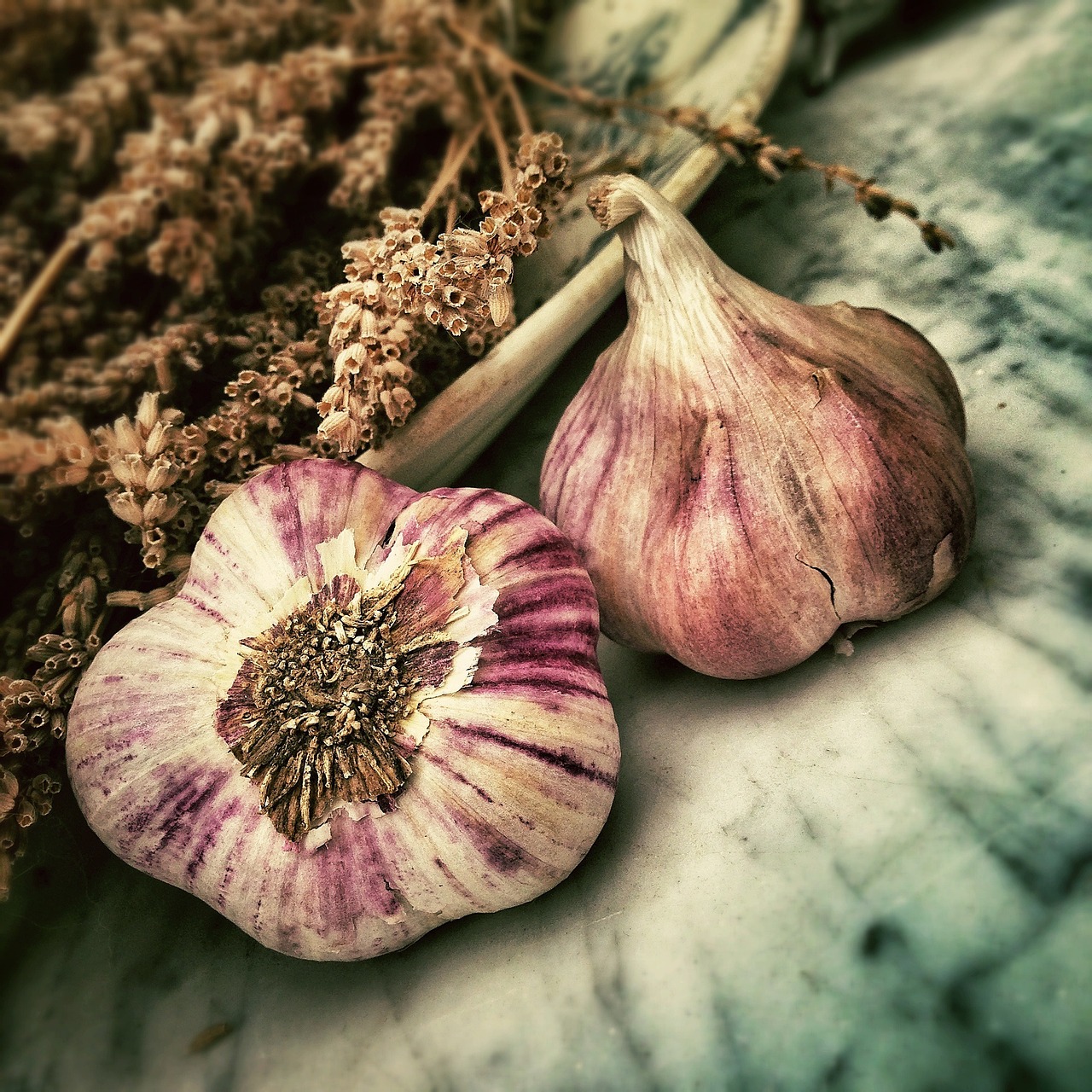
Engaging Your Pet's Senses
When it comes to making mealtime a delightful experience for your furry friend, engaging their senses can make all the difference. Just like humans, pets have preferences that can be influenced by what they see, smell, and taste. By incorporating a variety of sensory experiences into their meals, you can transform the mundane act of eating into an exciting adventure!
First, let’s talk about flavor variety. Pets, especially dogs and cats, can get bored with the same old kibble day in and day out. Imagine eating the same meal every day—yawn, right? To keep your pet excited about mealtime, consider rotating different flavors. For instance, you might have chicken one day, beef the next, and maybe even a fishy treat later in the week. This not only keeps things interesting but also ensures they receive a balanced intake of nutrients. You can even mix in some fresh fruits or vegetables that are safe for pets, like carrots or blueberries, to add a splash of color and flavor!
Next up is the importance of textural experiences. Just like humans enjoy a variety of textures in their meals, pets can benefit from it too! Imagine biting into a crunchy biscuit followed by a chewy piece of meat—what a delightful combination! You can create meals that include a mix of textures, such as crunchy kibble combined with soft wet food. This not only enhances their enjoyment but also promotes healthy chewing habits. Some pets may even prefer a certain texture over others, so it’s worth experimenting to find what your pet loves best.
Another way to engage your pet’s senses is through aromas. Pets have a highly developed sense of smell, often far superior to ours. The aroma of freshly cooked food can be irresistible to them. You might consider lightly warming their food before serving it, as the heat can help release enticing scents. Additionally, adding a sprinkle of herbs—like parsley or basil—can make their meal smell heavenly and provide some health benefits too!
To further enhance the sensory experience, consider serving their meals in a visually appealing way. Use colorful bowls or arrange their food in fun shapes. You can even create a little 'food art' by arranging their kibble and treats into a smiley face or a heart. This not only makes mealtime visually stimulating but also shows your pet that you care about their eating experience.
Finally, let’s not forget about the social aspect of mealtime. Engaging your pet’s senses can also be about the environment. Eating together can create a sense of community and belonging. Set up a cozy spot where you can both enjoy your meals together, perhaps with some soft music playing in the background. This not only makes your pet feel loved but also creates a positive association with mealtime.
In conclusion, engaging your pet's senses during mealtime is a fantastic way to enhance their eating experience. By incorporating a variety of flavors, textures, and aromas, you can turn a simple meal into a sensory feast that delights and nourishes your furry friend!
- How can I tell if my pet is enjoying their food? Look for signs of excitement, such as wagging tails, eager behavior at mealtime, and licking their bowls clean.
- What are some safe fruits and vegetables for pets? Some safe options include carrots, green beans, blueberries, and apples (without seeds).
- How often should I change my pet's food flavors? It's a good idea to rotate flavors every few days to keep mealtime exciting, but be sure to introduce new foods gradually to avoid digestive upset.
- Can I make homemade food for my pet? Yes! Just ensure that you’re following balanced recipes that meet your pet's nutritional needs.
Flavor Variety
When it comes to our furry friends, variety is not just the spice of life; it’s a key ingredient in their nutrition! Just like us, pets can get bored with the same old flavors day in and day out. Imagine eating the same meal for every breakfast, lunch, and dinner—yawn! By introducing a range of flavors into your pet’s diet, you not only keep their meals exciting but also ensure they receive a well-rounded intake of essential nutrients.
So, why is flavor variety so important? For starters, different flavors can stimulate your pet's appetite, encouraging them to eat more enthusiastically. This is particularly beneficial for picky eaters or pets recovering from illness. Additionally, varying flavors can help prevent food allergies and sensitivities that might develop from a monotonous diet. By rotating flavors, you’re not just treating your pet to a culinary adventure; you’re also promoting their overall health.
Here are some flavor profiles you might consider incorporating into your pet's meals:
- Meat-Based Flavors: Chicken, beef, lamb, and fish are great sources of protein and can be served in various forms, such as cooked, raw, or canned.
- Vegetable-Based Flavors: Sweet potatoes, carrots, and peas can add a touch of sweetness and crunch, making meals more appealing.
- Fruit-Based Flavors: Apples, blueberries, and bananas can be delightful treats that also provide vitamins and antioxidants.
- Herbs and Spices: Safe herbs like parsley or a sprinkle of cinnamon can enhance flavor without adding calories.
Experimenting with different combinations can lead to some delicious discoveries! For example, consider mixing chicken with sweet potatoes and peas for a hearty meal or combining salmon with blueberries for a tasty treat. The key is to observe your pet’s reactions—do they wag their tails a little more? Do they lick their bowls clean? These are good signs that you’re on the right track!
Moreover, introducing new flavors gradually can help your pet adjust without causing digestive upset. Start by mixing a small amount of the new flavor into their usual food, gradually increasing the proportion over several days. This approach not only helps your pet adapt but also allows you to monitor for any potential allergies or sensitivities.
In conclusion, keeping mealtime exciting with a variety of flavors is a simple yet effective way to enhance your pet’s dining experience. By being creative and attentive to their preferences, you can make every meal a delightful occasion that nourishes both their body and spirit!
Q: How often should I change my pet's food flavors?
A: You can change flavors as often as you like, but it's best to introduce new ones gradually. This helps prevent digestive issues and allows your pet to adjust to the new taste.
Q: Are there any flavors I should avoid?
A: Yes, some flavors can be harmful to pets, such as chocolate, onions, garlic, and certain nuts. Always do your research or consult with a veterinarian before introducing new ingredients.
Q: Can I mix different types of proteins in one meal?
A: Absolutely! Mixing proteins can be a great way to provide variety and ensure your pet gets a balanced diet. Just be sure to monitor their reaction to the new combinations.
Q: How can I tell if my pet is enjoying their food?
A: Look for signs such as wagging tails, licking their bowls clean, and showing excitement at mealtime. If they seem uninterested or leave food behind, it might be time to try a new flavor!
Textural Experiences
When it comes to our furry friends, the experience of eating is just as important as the food itself. Pets, much like humans, have preferences that go beyond mere taste; they are also influenced by texture. Imagine biting into a crunchy cookie versus a soft, chewy brownie. Each texture offers a distinct sensation that can enhance our enjoyment of food, and the same applies to our pets. By diversifying the textures in your pet's meals, you can make mealtime an exciting adventure rather than just a routine chore.
Think about it: a dog may relish the satisfying crunch of kibble, while a cat might prefer the smoothness of a pâté. Incorporating a variety of textures not only keeps your pet engaged but also promotes better chewing habits, which is essential for their dental health. A well-rounded diet that includes a mix of crunchy, chewy, and soft foods can create a delightful eating experience. For example:
- Crunchy: Kibble, raw veggies, or crunchy treats can help clean teeth and stimulate gums.
- Chewy: Soft treats or cooked meats can provide a satisfying chew that many pets love.
- Soft: Pâtés and wet foods are often favored for their palatability and ease of eating.
Furthermore, mixing textures can be a fun way to introduce new foods into your pet's diet. For instance, try combining crunchy kibble with a spoonful of soft wet food to create a delightful contrast. This not only piques their interest but also encourages them to explore their meals more thoroughly. You might even find your pet playing with their food, which is a sign of a happy and healthy eater!
So, how can you effectively incorporate different textures into your pet's meals? One approach is to create a texture chart that lists various foods and their corresponding textures. This can serve as a guide for meal planning:
| Food Type | Texture | Benefits |
|---|---|---|
| Kibble | Crunchy | Helps clean teeth, promotes chewing |
| Wet Food | Soft | Highly palatable, easy to digest |
| Raw Veggies | Crunchy | Low-calorie, adds fiber |
| Cooked Meats | Chewy | High protein, great for treats |
Incorporating a mix of these textures will not only satisfy your pet's palate but also contribute to their overall health and well-being. Always remember to observe how your pet reacts to new textures; some may take to it like a duck to water, while others may need a little coaxing. The key is to make mealtime a joyful experience that they look forward to every day!
Q: How can I tell if my pet prefers certain textures?
A: Pay attention to their eating habits. If they consistently leave behind kibble but devour wet food, they may prefer softer textures. Experiment with different foods to find their favorites!
Q: Is it safe to mix different textures in my pet's food?
A: Yes, mixing textures can be beneficial and enjoyable for your pet. Just ensure that all food components are safe and appropriate for their dietary needs.
Q: Can I introduce new textures gradually?
A: Absolutely! Gradually introducing new textures can help your pet adjust without overwhelming them. Start with small amounts mixed with their usual food.
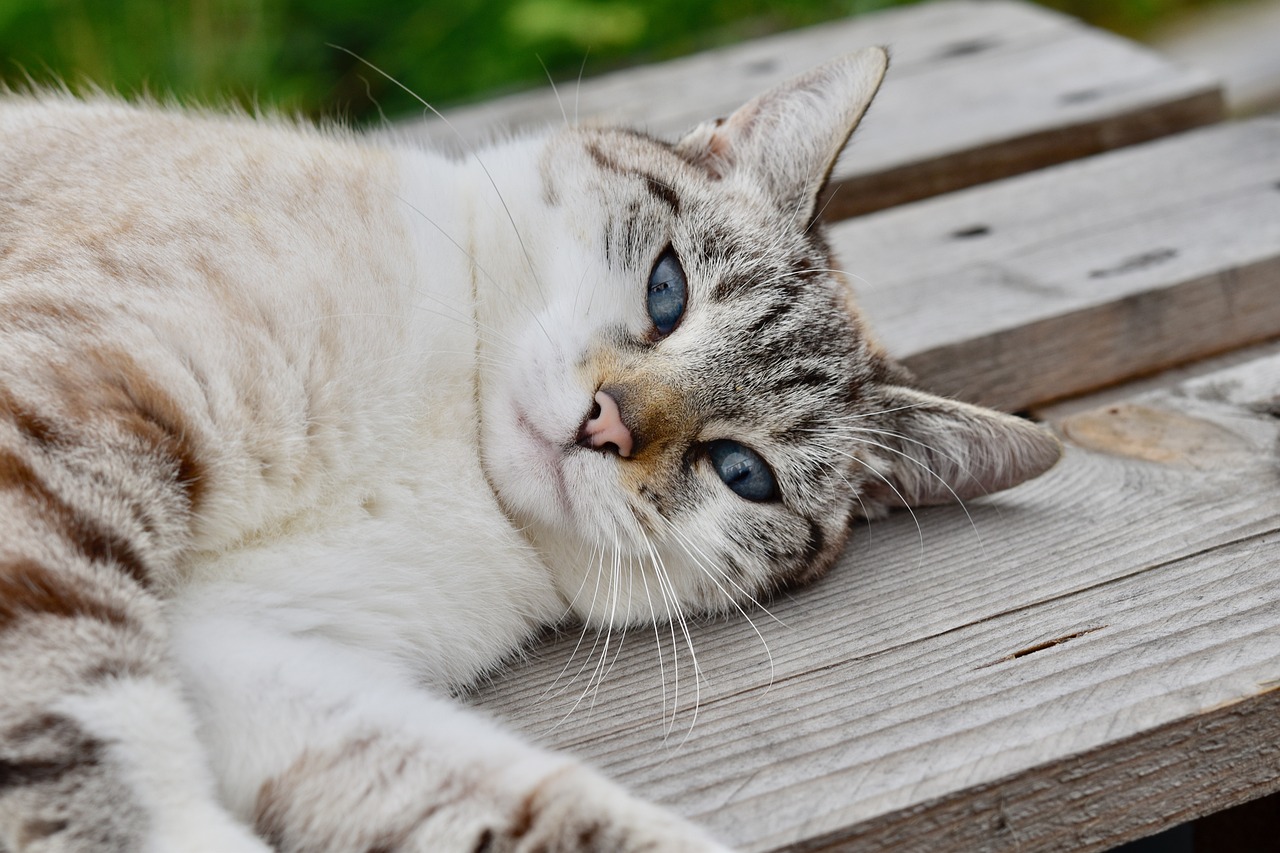
Making Mealtime a Routine
Establishing a consistent mealtime routine is crucial for your pet's overall well-being. Just like humans, pets thrive on predictability. Imagine how comforting it is to know that dinner is served at the same time every day! A routine creates a sense of security and helps regulate their digestion. When your pet knows when to expect food, they are less likely to experience anxiety or stress related to feeding times. So, how do you create this magical routine that benefits both you and your furry friend?
First, consider setting a feeding schedule. This means feeding your pet at the same time every day, whether it's breakfast, lunch, or dinner. Consistency in timing not only helps in regulating their digestive system but also allows you to monitor their eating habits more effectively. For example, if your dog is used to eating at 7 AM and 6 PM, they will naturally start to anticipate their meals at those times. You can create a simple table to help you plan this schedule:
| Day | Breakfast Time | Dinner Time |
|---|---|---|
| Monday | 7:00 AM | 6:00 PM |
| Tuesday | 7:00 AM | 6:00 PM |
| Wednesday | 7:00 AM | 6:00 PM |
| Thursday | 7:00 AM | 6:00 PM |
| Friday | 7:00 AM | 6:00 PM |
| Saturday | 7:00 AM | 6:00 PM |
| Sunday | 7:00 AM | 6:00 PM |
Next, think about incorporating treats wisely. Treats can be a fantastic way to reward your pet for good behavior or simply to show them love. However, moderation is key! Too many treats can disrupt their appetite and lead to weight gain. Instead of giving treats randomly, consider integrating them into your feeding routine. For instance, you could offer a small treat after they finish their meal, reinforcing the idea that good things come from eating their regular food. This not only encourages healthy eating habits but also strengthens your bond with your pet.
Finally, remember that every pet is unique. What works for one might not work for another. It’s essential to observe your pet and adjust the routine as necessary. If your pet seems anxious or disinterested in their food, it might be time to tweak the schedule or the type of food you’re offering. By paying close attention to their behavior and preferences, you can create a mealtime routine that is not only beneficial but also enjoyable for both you and your furry companion.
- How long does it take for a pet to adjust to a new feeding routine? Most pets will adjust within a week, but it can vary depending on the individual animal.
- Can I feed my pet at different times on weekends? It's best to maintain consistency even on weekends to avoid confusion.
- What if my pet refuses to eat at the scheduled time? If your pet refuses to eat, it could be a sign of stress or a health issue. Consult your veterinarian if this persists.
Feeding Schedule
Establishing a consistent feeding schedule for your pet is like setting a rhythm in a song; it creates a sense of harmony and security in their daily life. Just like humans thrive on routine, pets also benefit from knowing when to expect their meals. A well-structured feeding schedule not only helps regulate your pet's digestion, but it also contributes to their overall health and well-being.
When planning your pet's feeding schedule, consider their age, size, and energy levels. For instance, puppies and kittens have different nutritional needs compared to adult dogs and cats. Generally, younger pets require more frequent meals to support their rapid growth, while adult pets may thrive on a couple of meals a day. Here’s a simple guideline:
| Pet Age | Feeding Frequency |
|---|---|
| Puppies (up to 6 months) | 3-4 times a day |
| Adult Dogs (1-7 years) | 2 times a day |
| Senior Dogs (7+ years) | 2 times a day |
| Kittens (up to 6 months) | 3-4 times a day |
| Adult Cats (1-7 years) | 2 times a day |
| Senior Cats (7+ years) | 2 times a day |
In addition to frequency, the timing of meals is crucial. Aim to feed your pet at the same times each day. This not only helps them anticipate mealtime but also aids in digestion. For example, if you choose to feed your dog at 8 AM and 6 PM, try to stick to that schedule consistently. It’s like having a dinner reservation at their favorite restaurant—reliable and comforting!
Additionally, remember that portion control plays a vital role in maintaining a healthy weight for your pet. Consult with your veterinarian to determine the right portion sizes based on your pet's specific dietary needs. Overfeeding can lead to obesity, which can cause a host of health issues. On the flip side, underfeeding can leave your furry friend feeling lethargic and unwell. Striking the right balance is key!
Finally, keep in mind that pets, like people, can have off days. If your pet seems uninterested in their food, it might be a sign to reassess their schedule or diet. Perhaps they need a little variety, or maybe they’re not feeling well. Always be attentive to their behavior and adjust accordingly.
By creating a consistent feeding schedule, you not only promote a healthy lifestyle for your pet but also strengthen the bond you share. It’s a daily ritual that enhances their happiness and well-being, making mealtime a cherished part of their day.
- How often should I feed my pet? - It depends on their age and dietary needs. Puppies and kittens typically require more frequent meals than adults.
- What if my pet refuses to eat at the scheduled time? - Monitor their behavior closely. They might need a different type of food or a change in routine.
- Can I give my pet treats between meals? - Yes, but use moderation. Treats should not exceed 10% of their daily caloric intake.
Incorporating Treats Wisely
When it comes to treating our furry friends, it's easy to get carried away with the excitement of giving them something special. However, just like us, pets can easily indulge in too many treats, which can lead to unwanted weight gain and health issues. So, how do you incorporate treats into your pet's diet without compromising their nutrition? The key lies in balance and moderation.
First and foremost, consider the overall caloric intake of your pet. Treats should only make up a small portion of their daily calories—typically around 10%. This means if your pet requires 400 calories a day, only about 40 calories should come from treats. To help you visualize this, here’s a quick reference table:
| Pet Type | Daily Caloric Needs | Max Treat Calories |
|---|---|---|
| Small Dog (10 lbs) | 200 calories | 20 calories |
| Medium Dog (30 lbs) | 600 calories | 60 calories |
| Large Dog (60 lbs) | 1200 calories | 120 calories |
| Cat | 250 calories | 25 calories |
Next, it's crucial to choose the right kind of treats. Opt for nutrient-dense options that contribute positively to your pet's health. Look for treats that are high in protein and low in fillers like corn and soy. You might also consider homemade treats where you control the ingredients, ensuring they are both delicious and healthy. For instance, simple recipes using peanut butter, pumpkin, or sweet potatoes can be a hit with your pup!
Another effective strategy is to use treats as a training tool. This not only reinforces good behavior but also allows you to give smaller portions as rewards. Instead of a full-sized treat, break it into smaller pieces. Your pet will still feel rewarded while you keep their caloric intake in check.
Lastly, remember to keep an eye on your pet's overall health and weight. Regular check-ups with your veterinarian can help you gauge whether your treat-giving habits are on the right track. If your pet is gaining weight or showing signs of discomfort, it may be time to reevaluate your treat strategy.
In summary, incorporating treats wisely into your pet's diet is all about balance. By being mindful of caloric intake, choosing healthy options, using treats for training, and monitoring your pet’s health, you can ensure that treat time remains a joyous occasion without compromising their nutrition.
- How many treats can I give my pet daily? Aim for treats to make up no more than 10% of your pet's daily caloric intake.
- What are some healthy treat options for pets? Look for high-protein, low-filler treats, or consider homemade options like peanut butter or sweet potato biscuits.
- Can I use treats for training? Absolutely! Using smaller portions as rewards during training can help reinforce good behavior.
- What should I do if my pet is gaining weight? Consult your veterinarian to discuss dietary adjustments and treat moderation.
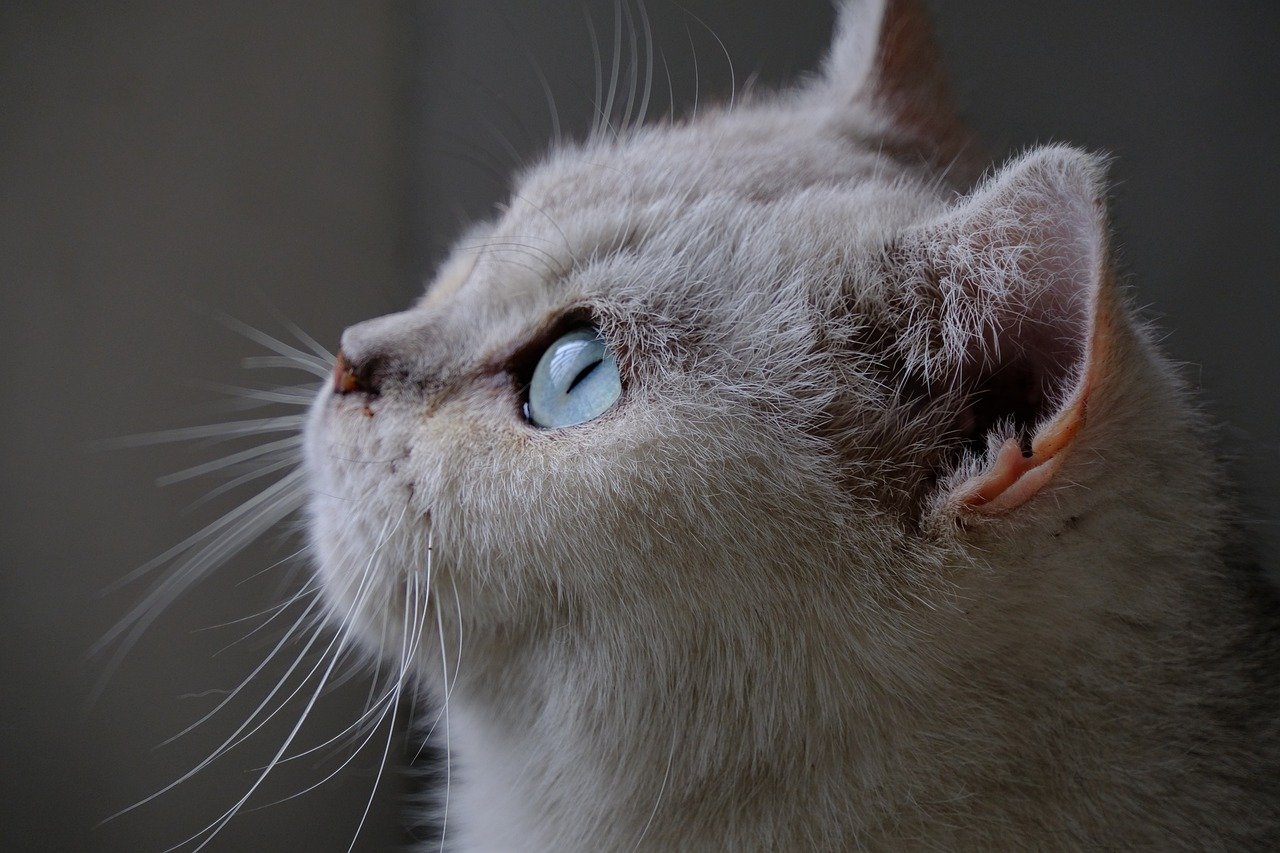
Celebrating Special Occasions
Celebrating special occasions with your furry friends can be one of the most delightful experiences for both you and your pet. Whether it's a birthday, adoption anniversary, or even a holiday, these moments offer a fantastic opportunity to strengthen your bond and create lasting memories. But how can you make these occasions truly special? The answer lies in combining fun, creativity, and nutrition!
First and foremost, consider planning a unique meal or treat that aligns with the occasion. For example, if it's your pet's birthday, why not whip up a homemade birthday cake specifically designed for pets? There are plenty of recipes available that use pet-safe ingredients like peanut butter, pumpkin, and oats. Imagine your dog’s wagging tail as they indulge in a slice of their very own cake! You can even decorate it with yogurt frosting or carob chips to make it look extra festive.
Holidays are another fantastic time to get creative. Think of holiday-themed treats that can make your pet feel included in the family celebrations. For instance, during Christmas, you might bake some gingerbread cookies using dog-friendly ingredients. Not only will this keep your pet happy, but it also allows you to share the joy of the season with them. Just remember to keep their dietary restrictions in mind when crafting these special meals.
It’s also essential to create an atmosphere of celebration. You could decorate your home with pet-friendly decorations, play some fun music, and even invite fellow pet owners over for a small gathering. This way, your pet can socialize and enjoy the festivities just like everyone else. After all, pets thrive on love and attention, and what better way to show that than by making them the center of attention on their special day?
Don’t forget to capture these moments! Take lots of photos during the celebration. Pets have a way of bringing joy to our lives, and having these memories documented will allow you to look back and smile. You might even consider creating a scrapbook dedicated to your pet's milestones and special occasions. This can be a fun project that you can look back on together.
In summary, celebrating special occasions for your pets is not just about the food; it's about creating an experience filled with love, joy, and connection. By planning thoughtful meals, engaging in festive activities, and cherishing these moments, you’ll not only enhance your pet's nutrition but also enrich their lives. So go ahead, make a plan, and let the celebrations begin!
- What are some safe ingredients for pet birthday cakes?
Common ingredients include peanut butter, pumpkin, applesauce, and oats. Always check for any allergens specific to your pet. - How can I include my pet in holiday celebrations?
You can prepare special treats, create a festive environment, and even have pet-friendly decorations to make them feel part of the festivities. - Are there any special dietary considerations for pets during celebrations?
Yes, always consider your pet's dietary restrictions and consult your veterinarian if you're unsure about any ingredients.
Birthday Celebrations
Celebrating your pet's birthday is not just about the cake; it's about creating lasting memories and making your furry friend feel special on their big day! Imagine your pet's joy as they dive into a delightful meal crafted just for them. It's a day to celebrate their unique personality and the joy they bring into your life. So, how can you make this day truly unforgettable?
First off, consider whipping up a homemade birthday cake tailored to your pet's dietary needs. You can use pet-friendly ingredients like pumpkin, peanut butter, and oats to create a delicious treat that’s safe and healthy. Here's a simple recipe to get you started:
| Ingredient | Amount |
|---|---|
| Whole Wheat Flour | 2 cups |
| Unsweetened Applesauce | 1 cup |
| Peanut Butter | 1/2 cup |
| Egg | 1 |
| Baking Powder | 1 tsp |
Mix these ingredients together, pour the batter into a cake pan, and bake at 350°F (175°C) for about 30-35 minutes. Allow it to cool, and you can even top it with a little yogurt or whipped cream for that extra flair! Just be sure to keep any harmful ingredients away—no chocolate or xylitol!
Next, think about how you can decorate your space to reflect the celebratory mood. Balloons, streamers, and a personalized banner can transform your home into a festive environment. Don't forget to invite a few of your pet's furry friends over for a paw-some party! This social aspect not only makes the day fun but also allows your pet to enjoy some playtime with their buddies.
Lastly, capturing these moments on camera is a must! Create a little photo booth with fun props—like hats and bows—so you can snap some adorable pictures to cherish. After all, these are the moments that will make you smile for years to come!
In summary, a pet's birthday celebration should be a joyous occasion filled with love, laughter, and yummy treats. By putting in a little extra effort, you can create a day that your pet will not only enjoy but will also strengthen the bond you share. So, what are you waiting for? Let the celebrations begin!
- What ingredients should I avoid in a pet birthday cake? Always avoid chocolate, xylitol, grapes, and any artificial sweeteners.
- Can I include my pet's friends in the celebration? Absolutely! Just ensure that all pets are well-socialized and comfortable around each other.
- How can I make sure my pet enjoys their birthday meal? Consider their preferences and dietary needs, and incorporate a variety of flavors and textures.
Holiday Treats
When the holiday season rolls around, it’s not just a time for family gatherings and festive decorations; it’s also an opportunity to include our furry friends in the celebrations! Just like we enjoy indulging in special treats during the holidays, our pets deserve a little festive flair in their meals too. Imagine your pet’s tail wagging with excitement as they savor a special holiday dish made just for them. It’s a delightful way to strengthen your bond and create joyful memories!
To get started, consider crafting some holiday-themed recipes that cater to your pet's dietary needs. For instance, you can whip up a batch of pumpkin and peanut butter biscuits that not only taste great but are also packed with nutrients. Here’s a simple recipe to get you going:
| Ingredient | Quantity |
|---|---|
| Pumpkin puree | 1 cup |
| Peanut butter (unsweetened) | 1/2 cup |
| Whole wheat flour | 2 1/2 cups |
| Egg | 1 |
Mix these ingredients together, roll out the dough, and cut it into festive shapes. Bake them until they’re golden brown, and you’ll have a batch of scrumptious treats that your pet will adore! Just remember to keep the ingredients pet-friendly and avoid anything toxic, like chocolate or certain spices.
Another fun idea is to create a holiday treat jar filled with various homemade goodies. You can use small mason jars and decorate them with ribbons and tags. This not only makes for a lovely gift but also allows your pet to enjoy a variety of flavors throughout the holiday season. Think of it as a pet-friendly advent calendar, where each day brings a new surprise!
Don’t forget about the presentation! Just as we love beautifully plated meals, your pets will appreciate a visually appealing treat. Try arranging their holiday goodies on a festive plate or in a special bowl. You can even add some seasonal decorations around their feeding area to make it feel extra special.
Lastly, while indulging in holiday treats, it’s essential to keep moderation in mind. Just like us, pets can overdo it on the treats, which could lead to health issues. So, balance is key! Incorporate these festive treats into their regular diet without going overboard. A little sprinkle of holiday joy can go a long way in making your pet feel loved and cherished during the festive season.
Q: Can I share my holiday food with my pet?
A: While some human foods are safe for pets, many can be harmful. Foods like chocolate, onions, and grapes should be avoided. Always check what ingredients are safe before sharing.
Q: How can I ensure the holiday treats are healthy?
A: Focus on using natural ingredients and avoid additives or preservatives. Homemade treats allow you to control what goes into your pet's food, ensuring they get the best nutrition.
Q: How often can I give my pet holiday treats?
A: Treats should make up no more than 10% of your pet's daily caloric intake. It's important to balance treats with their regular meals to maintain a healthy diet.
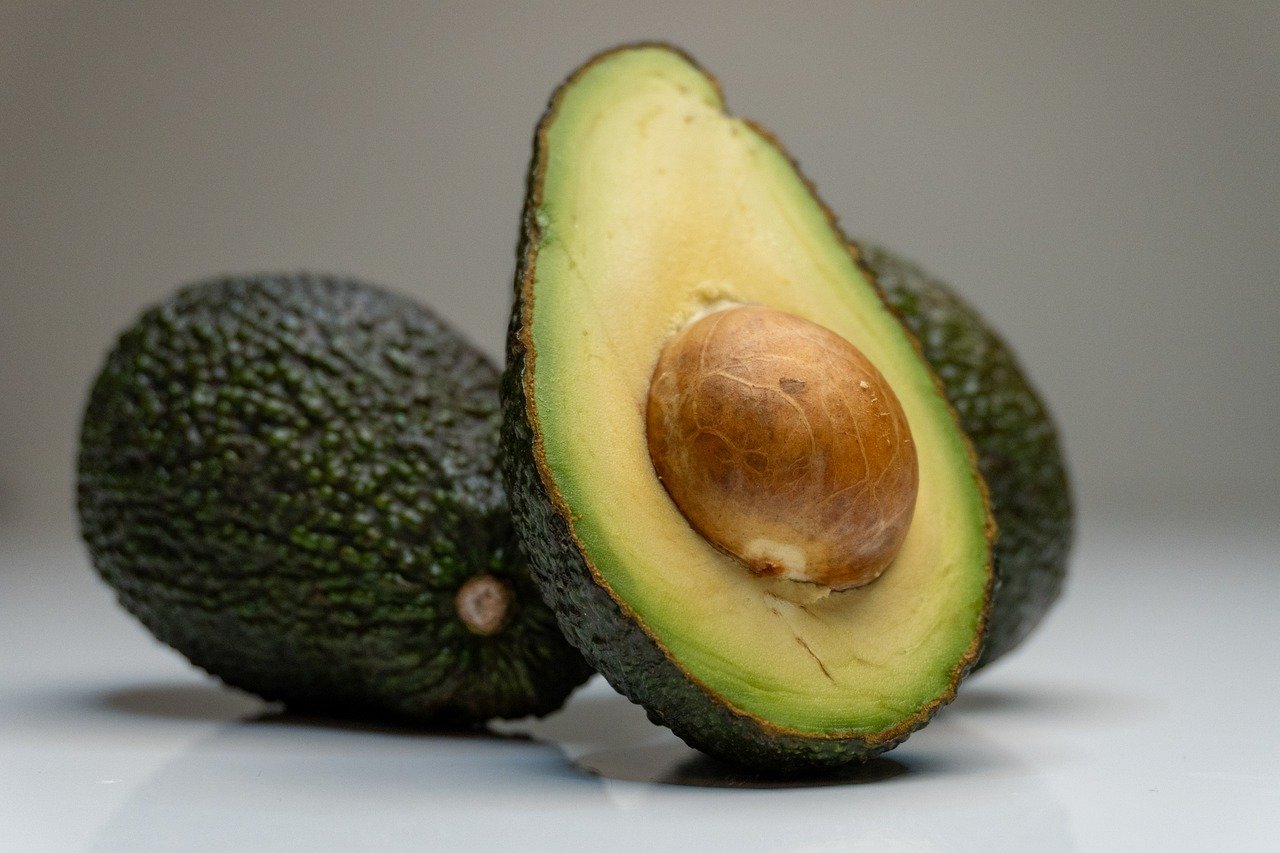
Monitoring Your Pet's Health
Keeping a close eye on your pet's health is crucial for ensuring they live a long, happy life. Just like us, pets rely on proper nutrition to thrive, and their dietary needs can change over time. Therefore, it's essential to understand how nutrition impacts their overall health and well-being. Regular check-ups with your veterinarian can help you stay informed about your pet's specific dietary requirements and any health issues that might arise.
One effective way to monitor your pet's health is by observing their behavior and physical condition. Are they energetic and playful, or do they seem lethargic? Changes in appetite, weight, or energy levels can be indicators of nutritional deficiencies or other health problems. For example, if your pet suddenly loses interest in their food, it might be time to consult a vet. Additionally, you should keep an eye out for signs of nutritional deficiencies, which can include:
- Dry skin or coat: This could indicate a lack of essential fatty acids.
- Weight fluctuations: Sudden weight gain or loss may signal dietary issues.
- Dental problems: Bad breath or difficulty eating can be linked to poor nutrition.
- Digestive issues: Vomiting, diarrhea, or constipation are signs that something is off.
Recognizing these signs early can make a significant difference in your pet's health. If you notice any of these symptoms, it's vital to consult with a veterinarian. They can help identify the root cause and recommend dietary adjustments or supplements to ensure your furry friend gets the nutrients they need.
Furthermore, regular vet visits allow for routine screenings and vaccinations, which are essential for preventing health issues. During these check-ups, your vet can assess your pet's weight, body condition score, and overall health, providing tailored advice for their diet and lifestyle. This professional guidance can be invaluable, especially if your pet has specific health concerns or dietary restrictions.
To help you stay on top of your pet's health, consider maintaining a health log. This can include details about their diet, any changes in behavior, and notes from vet visits. By keeping track of these factors, you can provide your veterinarian with a comprehensive overview of your pet's health, making it easier to spot trends or issues that may require attention.
Q: How often should I take my pet to the vet for check-ups?
A: It's generally recommended to take your pet for a check-up at least once a year, but older pets or those with health issues may need more frequent visits.
Q: What signs should I look for to know if my pet is healthy?
A: A healthy pet typically has a shiny coat, good energy levels, a healthy appetite, and regular bathroom habits. Any significant changes in these areas should be discussed with your vet.
Q: Can I change my pet's diet without consulting a vet?
A: It's best to consult with a veterinarian before making any significant changes to your pet's diet. They can help ensure that the new diet meets your pet's nutritional needs.
Signs of Nutritional Deficiencies
Just like us, our furry friends can show signs that their diet isn't quite hitting the mark. It's crucial to be vigilant and recognize these warning signals before they escalate into serious health issues. Here are some common signs of nutritional deficiencies that you should watch for:
- Changes in Coat Quality: If your pet's fur starts to look dull, dry, or even begins to shed excessively, it could be a sign that they are lacking essential fatty acids or other nutrients.
- Weight Fluctuations: Sudden weight loss or gain can indicate an imbalance in their diet. For instance, a lack of protein can lead to muscle loss, while too many carbohydrates can cause obesity.
- Behavioral Changes: Is your pet more lethargic than usual? A drop in energy levels can suggest they aren’t getting the right nutrients to fuel their activity.
- Digestive Issues: Regular vomiting, diarrhea, or constipation may signal that your pet isn't digesting their food properly, often due to a lack of fiber or other vital components in their diet.
- Dental Problems: Bad breath, gum disease, or tooth loss can be linked to nutritional deficiencies, particularly a lack of calcium and other minerals.
It's essential to act promptly if you notice any of these signs. Early detection can make a world of difference in your pet's health. Regular vet check-ups are a great way to keep track of your pet's nutritional needs and overall well-being. Your veterinarian can provide tailored dietary advice, ensuring your pet gets all the necessary nutrients for a happy, healthy life.
Remember, just like our bodies need a balanced diet to function optimally, so do our pets. By being proactive and attentive to their nutritional needs, you can help them thrive and enjoy a vibrant life.
Q: How can I tell if my pet is getting enough nutrients?
A: Monitoring your pet's weight, coat quality, energy levels, and overall health can give you clues about their nutritional status. Regular vet visits are also essential for professional assessments.
Q: What should I do if I suspect my pet has a nutritional deficiency?
A: Consult your veterinarian immediately. They can perform tests and suggest dietary adjustments or supplements to correct any deficiencies.
Q: Can I make homemade food for my pet to ensure they get proper nutrition?
A: Yes, but it’s important to consult with a vet or a pet nutritionist to ensure your homemade diet meets all of your pet's nutritional requirements.
Q: Are there specific foods that can help prevent nutritional deficiencies?
A: A balanced diet rich in proteins, healthy fats, vitamins, and minerals is key. Foods like lean meats, vegetables, and whole grains can contribute to a well-rounded diet.
Consulting with a Veterinarian
When it comes to your furry friend’s health, is not just a good idea; it’s essential! Think of your vet as the guardian angel of your pet’s dietary needs. They have the expertise to guide you through the maze of pet nutrition, ensuring that your beloved companion gets all the essential nutrients they require for a vibrant life. But why is this step so crucial? Well, just like humans, pets have unique dietary requirements that can vary significantly based on their age, breed, health conditions, and activity levels.
During your visit, your veterinarian can help you assess your pet’s current diet and suggest any necessary adjustments. They can also identify specific needs based on factors such as:
- Age: Puppies and kittens have different nutritional needs compared to adult or senior pets.
- Health Conditions: Pets with allergies, diabetes, or other health issues may require special diets.
- Activity Level: An active dog may need more calories and protein compared to a more sedentary one.
Moreover, your vet can provide you with valuable insights into commercial pet foods versus homemade diets, helping you make informed decisions that align with your pet's health goals. For instance, they might recommend specific brands that meet the nutritional standards set by pet food regulatory bodies. They can also help you understand how to read pet food labels, enabling you to choose foods that are truly beneficial for your pet.
It’s also essential to have regular check-ups, as these visits allow your veterinarian to monitor any changes in your pet’s weight, coat condition, and overall health. If you notice any unusual behaviors or signs of nutritional deficiencies, such as lethargy, poor coat quality, or digestive issues, don’t hesitate to reach out to your vet. Early intervention can make a world of difference!
In conclusion, consulting with a veterinarian is an invaluable step in ensuring your pet’s diet is not only enjoyable but also nutritionally balanced. Your vet can help you navigate the complexities of pet nutrition, ensuring your furry friend stays happy and healthy for years to come.
- How often should I consult with a veterinarian about my pet's diet? It's best to consult with your vet at least once a year, or more frequently if your pet has specific health concerns.
- Can I switch my pet's diet on my own? While you can make adjustments, it's always wise to consult your vet before making significant changes to ensure you meet your pet's nutritional needs.
- What signs indicate my pet might need a dietary change? Look for changes in weight, energy levels, coat condition, or unusual behaviors, and consult your vet if you notice any of these signs.
Frequently Asked Questions
- What are the essential nutrients my pet needs?
Every pet has unique dietary requirements, but generally, they need a balance of proteins, fats, carbohydrates, vitamins, and minerals. For example, dogs require protein for muscle development, while cats need taurine, an essential amino acid. Always check with your vet to tailor your pet's diet to their specific needs!
- How can I make mealtime more engaging for my pet?
There are plenty of fun ways to spice up mealtime! You can use interactive feeding toys that challenge your pet to work for their food, or even create DIY feeding toys from household items. Mixing up the flavors and textures of their meals can also keep them excited about eating!
- Is it okay to give my pet treats regularly?
Absolutely, but moderation is key! Treats can be a great way to reward your pet, but they should not make up more than 10% of their daily caloric intake. Opt for healthy, low-calorie options, and make sure they fit into your pet's overall nutrition plan.
- How often should I feed my pet?
Establishing a consistent feeding schedule is important for your pet's health. Most adult pets do well with two meals a day, while puppies and kittens may need more frequent feedings. Stick to a routine to help regulate their digestion and keep them feeling secure!
- What should I do if I notice signs of nutritional deficiencies?
If you suspect your pet is not getting enough nutrients, look for signs like lethargy, dull coat, or changes in appetite. It's crucial to consult with a veterinarian to assess their diet and make necessary adjustments to ensure they’re getting all they need to thrive.
- How can I include my pet in special celebrations?
Celebrating your pet's milestones can be a blast! You can prepare special meals or treats for their birthday or even make festive holiday-themed meals. Just ensure that any special food is safe and nutritious for your furry friend!
- When should I consult a veterinarian about my pet's diet?
If you're ever unsure about your pet's nutritional needs or if you notice any health changes, it's always best to consult a veterinarian. They can provide tailored advice based on your pet's age, breed, and health status, ensuring you make the best choices for their diet!


